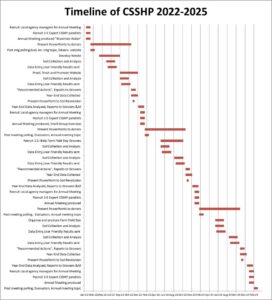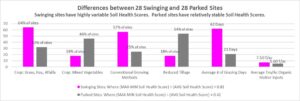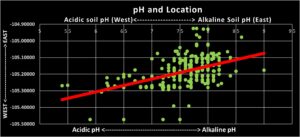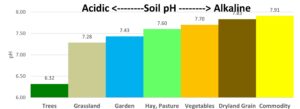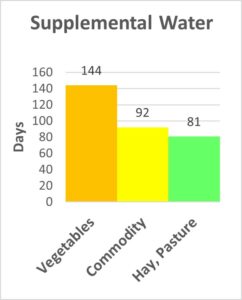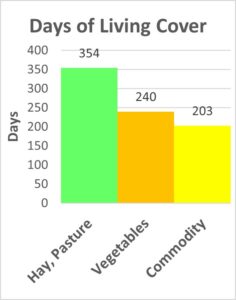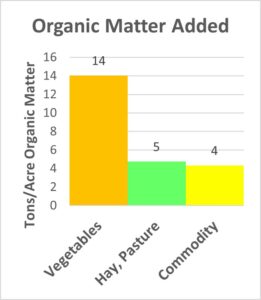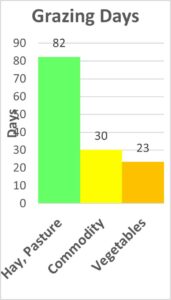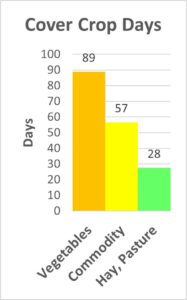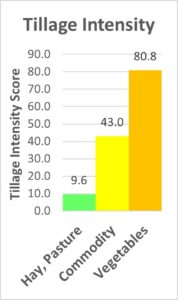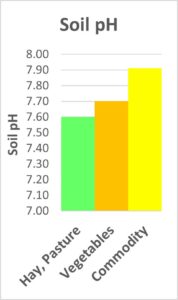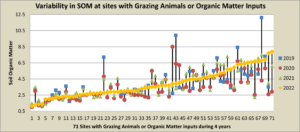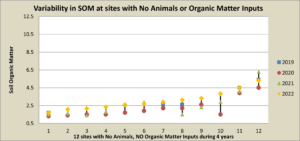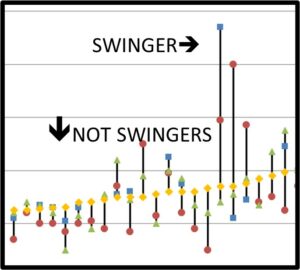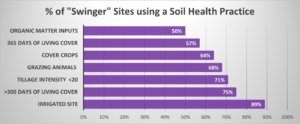Progress report for FW22-406
Project Information
After 3 years of soil testing, team building and information sharing, the CSSHP and our 47 participating growers have shown that lower pH, more water availability, better soil texture, more organic matter inputs, decreased tillage intensity, and more days of living cover result in better soil health. We have also identified 4 roadblocks to increased adaptation of soil health practices, which are:
1) Only half of participating growers understand their test results and which actions are indicated.
2) 53% of growers want more individualized consults with soil health experts.
3) Although our entire data set identifies broad soil health group trends, individual grower’s data is erratic, without clear trend lines for most growers.
4) Despite small gains in fellowship, schisms between organic and conventional growers remain and may increase, with the County’s GMO ban under review again.
To address these roadblocks, the CSSHP will add management recommendations, referrals to local soil health experts and cost-sharing referrals to our test-reporting program. We will plumb our data to identify sources of variability and add grower’s qualitative observations to supplement soil-test data. We will expand our team-building efforts to include a website, small-group problem solving exercises, and promotion of participating growers as subject matter experts. We will continue to monitor our growers’ practices, attitudes and understanding to ascertain whether these actions lead to an increased adoption of soil health practices, more fellowship, more information sharing, and the emergence of local soil health leaders among our participating growers.
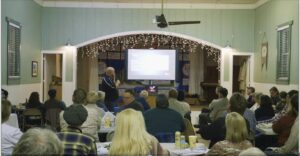
The Citizen Science Soil Health Project, Years 4-6, will address 3 questions: 1) Can simpler explanations of soil test results and referral to cost-share resources increase adoption of soil health practices? 2) Can increased fellowship and information sharing among growers expand local soil health successes while developing local soil health leaders? 3) Will obtaining additional soil health data reduce individual grower’s data variability and reveal individual grower’s trends?
Objectives: Participating growers will develop greater confidence and knowledge about soil health testing and results, as well as different strategies to improve their operation’s soil health. Through program participation, they will be provided resources and tools through local partners in understanding and interpreting their test results, as well as resources for potential funding sources to incorporate soil health systems. Throughout this process, peers will recognize several participating growers as subject-matter experts or soil health leaders in their field.
Cooperators
- (Researcher)
- - Producer
- - Technical Advisor
- - Technical Advisor
- - Technical Advisor
Research
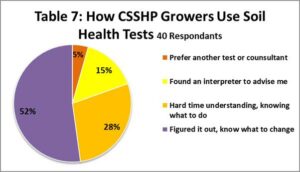 According to our recent poll, only about half (23) of CSSHP growers fully understand their soil testing results and use this information to drive management decisions (Table 7). The remaining CSSHP growers prefer a different test, have found an outside advisor to assist them in management decisions, or are challenged to understand their test results.
According to our recent poll, only about half (23) of CSSHP growers fully understand their soil testing results and use this information to drive management decisions (Table 7). The remaining CSSHP growers prefer a different test, have found an outside advisor to assist them in management decisions, or are challenged to understand their test results.
We see greater understanding of the confidential individualized year-end reports that we send to all growers (Table 8). Our year-end reports show growers how they compare with their peers on 10 important Haney and PLFA soil health indicators (soil organic matter, soil respiration, organic nitrogen, organic carbon, carbon-nitrogen ratio, pH, available N, available P, available K, total microbial biomass and Fungi : Bacteria ratio), as well as three management practices (days of living cover, organic matter inputs and tillage intensity). Growers are divided into two peer groups for comparison: the Tilled Fields Group and the Zero Tillage Group. The Year-End reports contain more graphics and 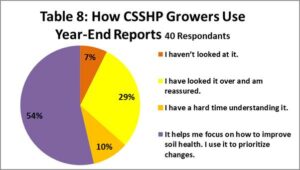 fewer categories to decipher than soil test results. It is designed so that a grower can easily see if they fall into the top, middle or bottom of the pack. (See attached PDF, “Example Individualized Progress Report”). This may explain why more growers understand the year-end report than their test results.
fewer categories to decipher than soil test results. It is designed so that a grower can easily see if they fall into the top, middle or bottom of the pack. (See attached PDF, “Example Individualized Progress Report”). This may explain why more growers understand the year-end report than their test results.
Given the feedback from our growers in Tables 6-8, it is clear that simply providing soil test results is not enough. We must expand our project to include annual individualized management advice based on testing results. Our previous objectives for the first 3 years of the project are still valid, but our approach to them must shift and expand, given feedback from our growers and our data variability problems. See Table 9 for new 2022 to 2024 goals, objectives and planned actions.
For Objective #1, Increase CSSHP growers' knowledge about soil health and use of soil health tests, we will provide growers with 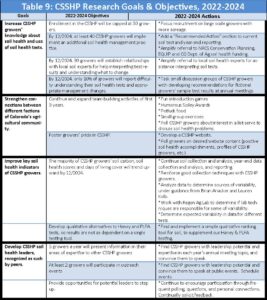 concrete management suggestions, based on their soil testing results, in addition to their regular test results and year-end reports. Our current 6-page “User-Friendly” soil testing results form is clearly too intimidating for many CSSHP growers. With help from Vanessa McCracken, the Boulder Valley and Longmont Soil Conservation District Manager and Lauren Kolb, the City of Boulder Open Space and Mountain Parks Senior Agricultural Program Manager, we will provide each CSSHP grower 1-3 individualized management recommendations, for their free soil test. Combined with consistent referrals to Vanessa McCracken for assistance with soil test interpretation, referrals to NRCS conservation planning for EQIP funding, plus practice deciphering soil health test results at annual meetings, we expect that more CSSHP growers will understand their test results and initiate appropriate actions.
concrete management suggestions, based on their soil testing results, in addition to their regular test results and year-end reports. Our current 6-page “User-Friendly” soil testing results form is clearly too intimidating for many CSSHP growers. With help from Vanessa McCracken, the Boulder Valley and Longmont Soil Conservation District Manager and Lauren Kolb, the City of Boulder Open Space and Mountain Parks Senior Agricultural Program Manager, we will provide each CSSHP grower 1-3 individualized management recommendations, for their free soil test. Combined with consistent referrals to Vanessa McCracken for assistance with soil test interpretation, referrals to NRCS conservation planning for EQIP funding, plus practice deciphering soil health test results at annual meetings, we expect that more CSSHP growers will understand their test results and initiate appropriate actions.
For Objective #2, Strengthen connections between different factions of Colorado’s agricultural community, we will build on activities of the past three years. We will continue to use humor and fun (speed-dating exercises, Soiley Awards), to introduce folks to each other and break down barriers. We will poll growers about their interest in a soil health listserv forum, as suggested by a CSSHP grower. Listservs are a double-edged sword. They can be a valuable forum of experts for problems and advice, like Whitney Cranshaw’s PestTalk through CSU. However, they can also devolve into a bunch of grumps saying mean things to each other. We must have strong buy-in from CSSHP growers and good boundaries to create a successful listserv. We have avoided creating a CSSHP website to date, because of past agricultural controversies in Boulder County. Keeping a low public profile at the beginning of the CSSHP was necessary to build trust with our growers. However, we now have enough good will, trust and group data to call for a project website. We will poll our growers on what our website should include, and build it according to their feedback.
For Objective #3, Improve key soil health indicators of CSSHP growers, with assistance from Brian Anacker, Chief Science Advisor for Boulder Open Space and Mountain Parks and Lance Gunderson, director of Regen Ag Lab, we will continue to collect data, and analyze our existing data, to determine the cause of the variability in our soil health testing results. Once we determine the cause, we can correct it. However, it is clear that we need a second soil assessment tool, so that we are not totally dependent on lab tests. We will find and implement a simple qualitative soil ranking tool for our growers, to supplement our Haney & PLFA testing. We will also re-emphasize proper collection techniques to try to eliminate that possible cause of our variability.
For Objective # 4, Develop CSSHP soil health leaders, recognized as such by peers, we will continue to ask various CSSHP growers to give presentations in their areas of expertise to the whole group and at outreach events. This will allow CSSHP growers to assess each other’s knowledge and leadership abilities. By continually encouraging participation and open discussion, we expect that a few leaders will rise to the top.
In the 21st century, we expect organizations and sectors to be nimble, able to change as quickly as the world around us. We expect them to rapidly adapt to new technologies, to turn on a dime like a drone. But agriculture is NOT like a nimble drone, flitting to and fro. Rather, it is like a huge super tanker, taking an exceedingly long time to turn. In agriculture, there is usually only one shot per year to try something new, and many reasons why that one shot might or might not work in that year, which then requires more years of testing, tweaking, and retesting. That is why the CSSHP is a 10 year long project. It is also why it will take us more than three years to figure out whether providing annual soil health testing, education and team-building leads to broader adoption of practices that improve soil health.
For Objective #1, Increase CSSHP growers' knowledge about soil health and use of soil health tests, we will provide growers with concrete management suggestions, based on their soil testing results. Please see Education Section.
For Objective #2, Strengthen connections between different factions of Colorado’s agricultural community, we will build on activities of the past three years. Please see Education Section.
For Objective #3, Improve key soil health indicators of CSSHP growers, we will continue to collect data, and analyze our existing data, to determine the cause of the variability in our soil health testing results. Please see next research section and narrative on our findings in 2022.
For Objective # 4, Develop CSSHP soil health leaders, recognized as such by peers, we will continue to ask various CSSHP growers to give presentations in their areas of expertise to the whole group and at outreach events. Please see Education sections.
Research Outcomes
Our recommendations for sustainable agricultural production and future research:
-
- Only half of participating growers understand their test results and which actions are indicated. They are more interested in what actions they need to take than their actual test results. It is hard for some of them to make the jump from a lab test result to a recommended action. Many of them need someone to help them interpret their soil testing results and recommend actions. However, soil health testing is relatively new and many local Ag advisors are not familiar with the tests and don’t have experience interpreting them. We need a program to teach local Ag advisors how to interpret soil health tests and how to advise growers based on those results.
- 53% of growers want more individualized consults with soil health experts. 51% of our growers said that they would like to receive a list of recommended actions to consider, in conjunction with their soil health lab reports. However, when we ran this idea by local conservation district staff and other Ag professionals, they said that they were already overtaxed with their current workload, and they could not take on any additional work. They also expressed reservations regarding the wisdom of making recommendations without a site visit to really understand the issues on a site, and without developing a more formal conservation plan for the site.
- Although our entire CSSHP data set identifies broad soil health group trends, individual grower’s data is erratic, without clear trend lines for most growers. We are seeing a great deal of variability (big swings up AND down) in individual soil health test results, which makes it very difficult to assess individual grower’s progress. More grazing days and greater organic matter inputs seems to correlate with more variability in soil health test results. The variability we are seeing makes me question the worth of spending a lot of money on soil testing (which is what we are doing at the CSSHP). For us, it turns out that the tests and their results are just the excuse folks need to get together and share information. It is the information sharing through annual meetings, Farm field days, short videos of CSSHP growers discussing their solutions, photos of others’ fields, and more where the change happens. Trust building is key, and trust-building takes many years of persistent human contact. So, it is really good that our project is 10 years long. A 3-year-long project (which is all most grants fund) is just too short.
- Much of Western Ag is supplied with Colorado River water, including our area, the Colorado Front Range. We all know that water travels uphill to money, so as Colorado River water becomes more scarce, Ag-water will be gobbled up by urban areas, leaving Ag with less and less supplemental irrigation water. Western research should be focused on how to maximize water yield for Ag in a time of dwindling supplies.
2024 Findings
PLFA PROBLEMS: This year, we saw illogical and precipitous drops in PLFA scores, but only on the soil samples our growers collected in the fall. The 3 graphs below illustrate this. The first 2 graphs show the 2019 and 2021 PLFA results for total microbial biomass for all our sites, with each dot representing one site’s score and the date it was collected. You can see a wide range of scores in both spring and fall for all our sites in both 2019 and 2021.


This third graph shows our sites’ total microbial biomass in 2023. This graph shows the same wide range of scores in the spring, but suddenly in the fall, all sites start having very low scores.
When we brought this to our lab’s attention, they initially suggested that the cause could be a very wet May-June-July followed by a very hot dry August-September-October, as we experienced in 2023. When soil microbial populations expand rapidly under favorable conditions like we experienced last May-June, they can sometimes use up all their available resources, and then suddenly crash. If this were the cause of our problem, we would expect to see a difference in the drops in PLFA scores of dryland fields, compared to fields which continued to receive supplemental irrigation water throughout the growing season. However, we did NOT see any difference between the total microbial biomass scores of our dryland fields and our irrigated fields, as the next graph shows.

We also checked to see if the amount of time samples were stored in freezers, or if the type of crops grown in the field were correlated with the drop in scores. They were not. We checked the Haney test scores which were pulled from the same soil samples. Haney test results were all within normal ranges. Our sampling and shipping protocols have stayed exactly the same for the last 5 years. All this means that the problem is most likely something that happened while the soil samples were in route to the lab, or at the lab itself.
Our lab has bent over backwards to ascertain the cause of this problem. They reran samples and re-calibrated their machinery multiple times, tore apart then cleaned and reassembled their machines, substituted all new reagents, switched lab techs performing the test, sent samples to other labs, re-checked other clients’ samples and results, called other researchers for advice, and bought several new parts for their machines. I have sent them new samples from now-frozen fields and am investigating whether our shipper might have done something to our packages in route. Our lab has finally isolated the problem to a combination of slight leakage within the gas chromatography machine, and an oven with variable inconsistent heat. The re-run results we have recently received seem more in line with previous years' results.
OUR GROWERS HAVE MADE PROGRESS!!: Reaching the halfway mark of a 10-year project is a good time to look back and assess the progress made in improving our soil’s health. The variability we continue to see in our lab results has thrown a great big monkey wrench into our ability to assess progress using only our lab results. (More on that in the next section of this report.) However, we can still assess the progress our growers have made in increasing their use of tried-and-true soil health practices, including:
- Increasing their Days of Living Cover
- Increasing their use of Cover Crops
- Decreasing their Tillage Intensity
- Increasing their Organic Matter Inputs
We have 5 years of data on the 51 sites which have been in the project since the very beginning, with data on both their management practices as well as their soil testing results. The following graph shows that the average Days of Living Cover of these 51 sites has increased by 20 days since 2019.

Our growers have increased their Days of Living Cover by increasing their use of cover crops, converting annual crops to perennial systems, and incorporating more fall-planted small grains into their rotations.
We examined the 200 sites for which we have cover crop data, and found that our growers’ Cover Crop Use has increased for almost all our crop categories including Commercial Veg/Flower/Fruit, Commodity Row Crops, and Home Gardens. Only when a rancher inter-seeds a cover into an existing pasture, or reseeds an annual field into a perennial crop do we credit a cover crop to that site, so we expect that cover crop use would be low for many of our established Perennial Hay/Alfalfa/Pasture sites. Dryland grain sites, which depend on 420 days of fallow soil to store enough soil moisture for a biennial small grain crop, avoid cover crops because cover crops can deplete soil moisture. Our growers have increased their days of cover crops on average by 25 days/site since 2019.


When we examine the Tillage Intensity of the 191 sites for which we have tillage data and group them into their 5 crop categories, we see that 4 crop groups have made very good progress in reducing their Tillage Intensity, with Commercial Veg/Flower/Fruit sites and Dryland Grains making the most progress. Perennial Hay/Alfalfa/Pastures have held steady with quite low Tillage Intensity scores.

When we examine just the 51 sites for which we have 5 years of data, we see the same trend of Tillage Intensity decreasing by 17 points over the last 5 years.

However, our news on Organic Matter Inputs is more mixed. The good news is that a majority of all our growers have used organic matter inputs on their sites in the last 5 years, with home gardeners leading the way. We only count the organic matter inputs which are acquired off-site in this analysis. Manure deposited by grazing animals on-site, or clippings from on-site cover crops, are not counted as organic matter inputs here. Thus, perennial fields with aftermath grazing often show as having no organic matter inputs, even though they may have many days of grazing animals depositing manure and urine in their fields.

However, the bad news is that when we examine our successive years of data and divide our sites into their different crop categories, we see that only home gardeners have increased their Organic Matter Inputs in 2023. All other crop categories have seen a sharp decrease in Organic Matter Inputs. Commercial Veg/Flower/Fruit growers have seen the biggest decrease. (See graph below.) Organic Matter Inputs have decreased by 13T/acre on average since 2019.

There are several possible causes of this decrease.
- We experienced an exceptionally wet May-June-July in 2023. Growers had a hard time planting, cultivating and harvesting between storms. They may not have wanted to or been able to get additional machinery into soggy fields to spread amendments.
- Our very tight labor market meant growers struggled all season to fill vacant positions. They may not have had enough workers to do things like spread amendments. Additionally, our tight labor market has increased labor costs sharply. This has affected Commercial Veg-Flower/Fruit growers the most as their crop category is the most labor intensive. Recent high labor costs may have consumed any profit that formerly paid for purchased amendments.
- Some growers with excessively high phosphorus levels may have decided to forego organic matter inputs and use cover crops instead, to avoid increasing their soil phosphorus to dangerous levels.
The table below summarizes our growers’ excellent progress incorporating soil health practices in 5 years:
|
Soil Health Practice |
Overall Progress 2019-2023 |
Assessment |
|
Days of Living Cover |
Average Days of Living Cover increased 20 days/year/site |
Good |
|
Days of Cover Crops |
Average days of Cover Crops increased 25 days/year/site |
Good |
|
Tillage Intensity |
Average Tillage Intensity score decreased 17 points/site |
Good |
|
Organic Matter Inputs |
Average Organic Matter Inputs decreased 13 T/acre/site |
Not Good |
VARIABILITY: We continue to see a great deal of variability in our lab results when we compare sites with themselves year-to-year. This year we divided our sites into 4 crop categories (Commercial Veg/Flower/Fruit; Commodity Row Crops and Dryland Grains; Home Gardens; and Perennial Hay/Alfalfa/Pastures) and examined each category’s variability. The 4 graphs below show that an examination of past practices can often explain some of the exceptionally big jumps in variability which we see in every crop group.
In the 4 previous graphs, each site’s 3-5 years of soil health scores are represented by a column of 3-5 colored data points connected by a vertical black line (a blue square for 2019, red circle for 2020, green triangle for 2021, yellow diamond for 2022 and aqua diamond for 2023). Each square-circle-triangle-diamond-Blackline combo represents the Soil Health Scores for one site for 3-5 years.
These 4 graphs show that Home Gardens and Perennial Hay/Alfalfa/Pastures have the most variable soil health scores year-to-year. Last year we showed that large amounts of organic matter inputs and more days of grazing animals increased variability. This year we have shown that home gardeners apply the highest rates of organic matter to their sites, and we know that grazing animals are usually found in pastures. It makes sense then that Home Gardens and Perennial Hay/Alfalfa/Pastures would experience the greatest variability in Soil Health Scores.
SWINGING SITES VS PARKED SITES: This year, we decided to compare our sites with the most variable soil health scores (our Swingers) with our sites with the least variable scores (our Parked sites). We calculated the Percent Relative Range ((maximum score minus minimum score) divided by average score) of scores for each site, and compared the 28 sites with the largest Percent Relative Range (our Swingers) with the 28 sites with the smallest Percent Relative Range (our Parked sites). Several significant differences became apparent, as shown in this graph.
2/3rds of Swinging sites are pastures, and the majority of Swinging sites use conventional growing methods. Swinging sites also apply an average of 7.5 T/acre of organic matter inputs, almost half again as much as Parked Sites at 5.6 T/ac. Almost half of the Parked sites grow mixed vegetables and use reduced tillage. The most significant difference between the 2 groups is that Swinging sites have 3 times the number of average grazing days as Parked sites. While Swinging and Parked sites have the same numbers of sites with grazing animals, Swinging sites have animals grazing on-site for a much longer period of time. These findings support our 2022 findings that more grazing animals and organic matter inputs increase variability.
Many thanks for reading all the way to the end! I hope you have found it interesting and informative.
2023 Findings
SOIL PH AND LOCATION: In previous years, we have found that as pH increases and becomes more alkaline, soil health decreases. We wondered if geographical location could have anything to do with pH, and indeed it does. We compared our sites’ soil pH with longitude (east-west location). We found that sites further east out on the plains tend to have higher pH than sites closer to the Front Range foothills and up in the mountains. This could be due to several things.
Precipitation is higher in the mountains and foothills than further out on the plains. Higher rainfall is associated with more acidic soils. Also, a site’s original parent soil material is more acidic in the mountains and foothills than on the plains. Furthermore, the pH of irrigation water can change soil pH with repeated applications. Irrigation water becomes more alkaline as it travels further east, picking up tail-water, salts and minerals. All this means that the location of a field might determine its soil pH as well as its soil health, since soil pH has a significant effect on soil health.
We wondered if certain kinds of sites might be located further east or west, thus influencing their soil pH. We sorted our sites into 7 groups. Most groups include both organic and conventional fields.
- Dryland Grains : Dryland wheat and millet, no irrigation, using a crop-fallow system.
- Commodity Row Crops: Irrigated crops like corn, triticale, wheat, hemp, beans, sugar beets, barley, millet, silage.
- Commercial Vegetable/Flower/Fruit : Irrigated vegetables, flowers and fruit, sold commercially.
- Perennial Hay/Alfalfa/Pasture: Irrigated perennial pasture systems of grass, hay and alfalfa.
- Home Gardens: Vegetables, flowers and fruit trees for home consumption.
- Non-farm Grasslands : Dryland grasslands with no recent tillage or farming practices.
- Trees : Forests and tree farms.
We then calculated each group’s average longitude, and calculated the average pH for each of the 7 groups, as shown in the next 2 graphs. No surprise, trees are located to the west in our forests, with dryland gains and commodity crops located to the east, where large sections of undeveloped agricultural lands remain. The order of the average pH of the 7 groups closely corresponds to their relative longitude. These 2 graphs suggest that some crop groups face more of a disadvantage than others when it comes to soil health, since their location can determine their soil pH, which in turn can make improving their soil’s health more difficult.
SOIL HEALTH OF 3 DIFFERENT CROP GROUPS: In previous years, we learned that more supplemental irrigation water, more days of living cover, more organic matter inputs, more grazing days and more use of cover crops can all improve a site’s soil health. We have also learned that lower tillage intensity and a lower soil pH improves a site’s soil health as well. We decided to calculate the average use of each soil health practice for the 3 crop groups which most of our growers are in: 1) Hay/Pastures/Alfalfa, 2) Vegetables/Fruit/Flowers, and 3) Commodity Row Crops. We wondered if each crop groups' average soil health practices could predict which crop groups would have the lowest and highest soil health scores. See if you can predict which crop groups with have the best and worst soil health scores, just by looking at their relative rankings on soil health practices. Remember that you are looking for HIGH water days, HIGH days of living cover, HIGH organic matter inputs and HIGH grazing days, but LOW tillage intensity and LOW soil pH to predict the highest soil health scores.
The following table has the average soil health scores of each of the 3 groups, for Soil Organic Matter, Soil Respiration, Organic Nitrogen, Organic Carbon, Soil Health Score, Total Microbial Biomass, and Number of Fungi, using the Haney and PLFA soil health tests.
| Crop Category | Average Soil Organic Matter | Average Soil Respiration | Average Organic nitrogen | Average Organic Carbon | Average Soil Health Score | Average Total microbial Biomass | Average Number of Fungi |
| Perennial Hay Alfalfa Pasture |
4.00 |
138 |
19 |
240 |
17 |
5161 |
589.3 |
|
Commercial Veg Flower Fruit |
3.16 |
71 |
20 |
230 |
13 |
3434 |
400.4 |
| Commodity Row Crop |
2.58 |
35 |
16 |
175 |
9 |
2924 |
285.2 |
Perennial Hay/Alfalfa/Pastures : The Pasture group has the highest average soil health scores of these three crop groups. Although the Pasture group has lower supplemental water days and lower organic matter added, their very high days of living cover and very high grazing days, along with their very low tillage intensity and lower soil pH seem to more than make up for their water challenges, in terms of soil health.
Commodity Row Crops : The Commodity crop group has the lowest average scores of these three groups. Although they have done an excellent job of reducing their tillage intensity, that fact alone cannot make up for their high soil pH, lowest days of living cover and lowest organic matter added. They have only 2/3rds of the water availability as the Commercial Veg/Flower/Fruit group, which explains their lower days of cover crops that often require fall seeding and fall water. Inter-seeding cover crops aerially or when the main crop is still small are work-arounds but not always practical. Low commodity prices mean the cost of additional organic matter inputs like compost and manure are hard to justify.
Commercial Veg/Flower/Fruit: The Commercial Veg group has the highest tillage intensity by far, but also triple the organic matter inputs of the other 2 groups. These huge organic matter inputs, along with their longer water season, greater use of cover crops, and lower pH overpowers their intense tillage and boosts their average soil health scores above the commodity crops’ averages. Their longer water season means they can plant more fall cover crops and string together succession plantings for a longer growing season. Their high value vegetables mean that they can afford organic matter input costs and hauling fees.
VARIABILITY: We continue to be plagued with a great deal of variability in our lab results when we compare sites with themselves year-to-year. Last year we determined that grazing animals contribute to variability in lab results. This year we asked, “Does adding organic matter like compost, manure and mulches to a site also make lab results more variable year-to-year?” The answer: It seems to.
In the first graph below, 71 sites with both grazing animals and organic matter inputs (OMI) are each represented by a quadruplet of data points connected by a vertical black line. Each square-circle-triangle-diamond-black-line combo represents the Soil Organic Matter (SOM) values for one site for 4 years. According to the literature, SOM is supposed to be quite stable and very difficult to change, and yet we are seeing large swings in individual sites’ SOM data, especially when grazing animals are present or organic matter is imported to the site, as is the case in the first graph below. We only have 12 sites in our study which have no grazing animals or imported organic matter for 3 or more years. The second graph shows that the variability in SOM values for these 12 sites is much less than for sites in the previous graph.
We then sorted our sites into 3 groups and calculated the average variability for each group. The bar graph below shows that the groups which grazed animals or added organic matter to their sites for 2 consecutive years have approximately three times as much variability in their lab results as the group with NO grazing animals and NO organic matter inputs.
Finally, we examined the 28 sites which have the most variability in their soil health scores. We call these sites our “Swingers”, and they are evenly split between organic and conventional growing methods. Over half the “Swinger” sites are pastures with the rest split evenly between home gardens and commercial vegetable sites. Their most common crop is grass hay with mixed vegetables coming in second. Their average water season is 127 days long. “Swinger” sites have an average soil health score of 27.6, which is very high, especially for Colorado. The growers of these “Swinger” sites are all Soiley Award winners or nominees. They have adopted many soil health practices, as you can see in the following graph.
The lesson here seems to be that no good deed goes unpunished. It seems that one result of adopting good soil health practices may be a great deal of variability in soil health lab results. If you see your Haney test results bouncing around a lot, year-to-year, it does not necessarily mean that you are doing anything wrong. It may mean that you are doing many things right! We will explore this hypothesis further in coming years as we gather more data.
GRANTS AND COLLABORATORS: We secured a generous partnership grant from St. Vrain and Lefthand Water Conservancy District, and a small grant from the Boulder County Sustainability Food and Agriculture Fund, which we have used to expand our educational outreach. We receive an annual stipend from City of Boulder Open Space and Mountain Parks for our research with their lessees. We have also received 4 very generous anonymous private donations. We added 6 growers to our 47 growers and lost 3. We now have 50 growers participating in the project and will not accept any more growers unless others drop out.
Education and Outreach
Participation Summary:
EDUCATIONAL OUTREACH
We have exceeded our educational outreach goals in some areas but not in others. Goals we have reached include:
- Our third annual meeting (2/22/22) for our participating growers and local Ag staff was both in person and on Zoom. Approximately 35 people attended. Outside speakers and CSSHP growers discussed various ways to maximize water yield, including:
- Christine Newton NRCS: increasing water infiltration by increasing soil health.
- Sharcy Ray NRCS and Paul Schlagel: NRCS funding for water system upgrades and soil health initiatives.
- Joel Schneekloth CSU Extension and Michael Moss: Soil Moisture Monitoring Technology
- Sean Cronin SVLHWCD: Funding available from SVLHWCD for water system upgrades
- Jim Snow, Catherine Long Gates and Cody Oreck, Silver Lake Ditch: Lining Irrigation Ditches
- In August 2022, we built, published and publicized our new website, SoilHealthProject.org, which includes our goals, processes, supporters, grower profiles, findings, articles, forms, and links to our videos on our You-Tube channel.
- In February of 2022, 2023 and 2024, we compiled and distributed individual progress reports for each of our growers, showing them how their results compared with their peers on 10 soil health indicators and 3 soil health practices: Days of Living Cover, Tillage Intensity and Organic Matter Inputs. We also included graphs showing them their changes over the 4 years of the project for 5 soil health indices: soil organic matter (SOM), respiration,
organic nitrogen (WEON), organic carbon (WEOC), and soil health score. 
- In July 2022, we reported on our progress to the St Vrain and Lefthand Water Conservancy District board meeting of approximately 30 growers and Ag professionals.
- Our 4th Annual meeting (2/16/23) for our participating growers and local Ag staff was both in person and on Zoom. Approximately 32 people attended. 3 CSSHP growers discussed various soil health practices they are using, followed by lively Q&A sessions with attending growers. During our annual meeting, we were plagued by "ghost touch bubbles" on our main computer screen, which impacted the quality of our Zoom meeting and Zoom recordings. (Ghost Touch Bobbles are when the touch screen on a laptop malfunctions and starts opening and closing screens randomly, as if a ghost is touching the screen.) Fortunately, we were able to get voice recordings of our speakers from Zoom, and made 3 amateur videos of our speakers from their slides and voice recordings.
- Jerry DeBruyne: NRCS Funding for Livestock Tire Tanks Video Link: https://youtu.be/2wHeUlfWkQ4
- Bob Condon: Cover Crops for Pumpkins, Video link https://youtu.be/-DKXKHAlCKQ
- Vanessa McCracken and Jules Van Thuyne: 2021 and 2022 corn test plots, Video link: https://youtu.be/d0RdEhnl9-g
- According to our growers' requests, our 4th Annual meeting (2/16/23) also included small-group break-out sessions to practice interpreting soil health tests and gain a better understanding of what the lab results mean. Growers divided into 3 groups (Pastures, Veggies and Commodities) and each discussed 2 different sample lab tests with local Ag professionals leading each group. These group discussions were less successful than I had hoped, since some of the Ag professionals leading the groups were not very familiar with Haney and PLFA tests.
- In February 2022, 2023 and 2024, we distributed our Year-End report to all our growers, advisors, donors, and supporters (179 people/groups). It includes our annual progress, upcoming goals, stats, finances and research findings.
- We produced 3 more videos in 2023 featuring CSSHP growers, including:
- Randy Pistachio on the Aerated Static Pile Composter at Long's Iris Gardens: https://youtu.be/i07WJRg-dYA
- Soil Erosion on Boulder OSMP Land with Prairie Dogs: https://youtu.be/T8772QvgDzA
- Elizabeth Black on Seedling Tree Survival Tips for Colorado's Front Range: https://youtu.be/SwBMO3zvJ4c
- Our You-Tube channel got over 19,000 views in 2023.Videos include the 6 listed above plus:
- Dale Strickler discusses cover crops for the semi-arid Front Range: https://youtu.be/lX8xxuKyNRw
- 4 CSSHP growers relate their experiences with cover crops: https://youtu.be/Zushgp1HQak
- Lance Gunderson explains the Haney soil test: https://youtu.be/buWErVOQSTw
- Lance Gunderson explains the PLFA soil test: https://youtu.be/ueD_4yvnWq0
- Silver Lake Ditch board members explain lining irrigation ditches: https://youtu.be/wMgcMM2TPXg
- Jules Van Thuyne discusses water conservation for Colorado corn: https://youtu.be/vnPs8SgM5m4
- Our website SoilHealthProject.org , has garnered over 800 views in 2023. We will continue to update it with our new videos, grower profiles and findings. It is updated each March with our previous year's findings.
- In October 2023, I reported our 2023 findings to both the Boulder Valley and the Longmont Conservation District Boards, which includes 12 of our leading growers.
- Our annual Soiley Awards always include an educational component. For example, here is the announcement for our 2022 Soiley Award winner: "The Soil Organic Matter Award, goes to the grower with the highest soil organic matter this year. Soil Organic Matter helps form stable soil aggregates, improves water-holding capacity, and provides a slow-release of nutrients. Our winner regularly applies homemade compost every spring, disturbs her soil as little as possible using only a broadfork, and regularly plants a fall cover of oats and clover. Our winner is ……….."
- In 2023, we held a Soiley Underwear Challenge, with a $500 cash prize for the most disintegrated pair of undies. Growers were encouraged to bury a pair of tidy whities and send in a photo of the deed to enter the contest. 13 growers entered the contest last summer. 4 couldn't find their buried undies in the fall. In all 12 pairs were successfully excavated and entered in the contest. 2024 Annual Meeting attendees voted for the most disintegrated pair, and awarded the $500 prize to 7 year-old Mae Thode who says she will use the money to buy some pigs. We also displayed the undies at Boulder's Soil Revolution Conference, along with signage describing each site where they were buried.
- Our 2024 Annual Meeting on February 20, 2024 included presentations from 5 CSSHP growers on strategies they are using to improve their soil's health. The meeting was in-person only. 35 CSSHP growers and 6 Ag professionals attended. Attendees were very relaxed and conversations were animated and extended. We made 5 videos of our speakers, and have published them on our You-Tube channel. They include:
- Dave Asbury of Full Circle Farms on Boulder County’s Sustainability Grant Funding for Organic Grain Storage https://youtu.be/9p8NPj2sqVc
- Bill Howland of Nine Mile Ranch on Applying Wood chips to Hay fields to Improve Soil Health https://youtu.be/mDwNUo6n0hk
- Dan Murphy of Boulder Better Wagyu on Soil Health Upgrades to Neighbors’ Lands for Grazing Trade https://youtu.be/ab1t1Z9PKbE
- Larry Lempka of Los Rios Farm on Cover Crops and the Mysterious Disappearing Kochia https://youtu.be/-QDEeCrHs1o
- Zach Thode of Lehi Ranch on Results of a Corn-Intercropped-with-Alfalfa Grazing Experiment https://youtu.be/V8d9kY2VcKU
- Dave Asbury of Full Circle Farms on Boulder County’s Sustainability Grant Funding for Organic Grain Storage https://youtu.be/9p8NPj2sqVc
- We continue to search for more ways to increase information exchange between our growers. Strategies we have tried include introduction games, a slide show of growers' cover crop photos, an annually updated and distributed contact list of all CSSHP growers, potlucks, contests and humor. I also try to connect a grower with another grower who has dealt with a similar problem, when the opportunity arises. So far, these efforts are slowly working.
Educational Goals we did not accomplish include:
- Recommended Action Reports for our growers: 51% of our growers said that they would like to receive a list of recommended actions to consider, in conjunction with their soil health lab reports. However, when we ran this idea by local conservation district staff and other Ag professionals, they said that they were already overtaxed with their current work load and they could not take on any additional work. They also expressed reservations regarding the wisdom of making recommendations without a site visit to really understand the issues on a site, and without developing a more formal conservation plan for the site. We will continue to try to find ways to address this need that our growers have expressed while working within the limitations of local resources.
- Public Outreach of Findings at the Soil Revolution Conference: Organizers of our local Soil Revolution Conference told us that the agenda was already full with other speakers in 2022 and 2023. We will continue to pursue other opportunities to share our findings with other coferences and groups.
- Farm Field Day in 2024: I anticipate a great deal of difficulty finding CSSHP growers who will be willing to host a Farm Field Day this summer. Several of our best veg growers are facing possible bankruptcy due to labor shortages and rising labor costs. All growers seem stressed by economic challenges outside of their control. But its early days and we may still be able to pull a Farm Field Day off.
Education and Outreach Outcomes
I have trialed various methods of reaching and involving our growers to further the goal of changing practices and developing soil health leaders. I have tried:
- Asking for advice individually or through group polling
- Awarding prizes of cover crop seed gift certificates
- Asking growers to speak on panels at our annual meetings
- Making videos of gowers discussing different soil health related subjects
- Sidestepping the organic versus conventional controversy
- Being as transparent as possible about all project matters including finances
- Admitting mistakes, errors and lack of knowledge when they occur
- Sharing some personal information
- Injecting humor where possible
It is unclear how effective any of these strategies have been. My impression is that what has made the most difference is TIME. The fact that this project has continued for 4 years with 6 years left to go, the fact that I am still around and still doing all the things I said I was going to do, the fact that I am old and have lived in this community for many years and don't seem to be heading off anywhere else, all these things all together have very slowly built up a small level of trust. Our most recent annual meeting was much more relaxed and growers seem to be interacting more with each other and generally having a good time. It was a very encouraging sign. Trust in the project, the process, and fellow growers is a necessary first step before other project goals such as information sharing, practice change and leadership development are realized.
Accordingly, my main recommendation is: Make sure you have plenty of TIME to accomplish your desired changes. It takes a long long time in most cases.
CHANGES IN SOIL HEALTH PRACTICES
22 growers reported changes in their soil health practices. Changes included the following:
- Change to Green Cover Seed for fall mix; Add summer straw mulch to most beds
- Increase time between grass mowings
- More turf and compost moved under landscape fabric
- minimum till
- manure
- cover cropping 3/4 ac; leaf mold compost and amendments; inoculating with mycorrhizae
- cover cropping; inoculating with mycorrhizae; decrease P inputs
- We continue to use the same sand and organic material mix. We are also utilizing a carbon based organic acid to help feed and promote microbrial activity in the soil.
- running theAerway twice a year instead of once a year
- Added compost at end of season
- Attempted to mow a cover crop, solarize and use as a mulch to plant transplants into- was not successful
- Heavy Straw on beds
- limited weeding/tillage to 4" or so on either side of iris rows, mowed in between rows
- minimized disturbance with no-till drill seeding
- minimized soil disturbance to area a few inches either side of iris rows and mowed in between rows
- only harvested part of the iris rows to minimize area disturbed
- Used no-till drill.
- Manure/wood chip application in November following oat harvest.
- Applications of: Compost, HyprGrow, Pantego Thrive, Rhizolizer, Chitosan, Citric Acid
- Compost
- Compost, Pantego, Chitosan, Citric Acid
- HyprGerm, HyprGrow, Pantego, Compost, Grazing
- HyprGrow, Pantego, Rhizolizer, Cover crops
- myceliated wood chips in December; doughnut mounds around trees in orchard to inoculate soil.
- manure applications
- compost application in spring
- Same as last year, 1/2 compost, soil sample area=compost
- Pivot-bio 40 microbial inoculation for increasing soil N
- cover crop planted 9/30/22
- continued with cover crop (70% grass; 30% legume) followed by dairy manure
- applied wormcast tea with humic and fulvic acids and microbial inoculants when performing the Yeomans rip and plant.
- Companion Cash Cropping
- Cover crop
- cover crop fall 2021, then terminated in June with tarps, planted next crop into residue.
- Concentrated on getting water to dry spots using NuFlex
